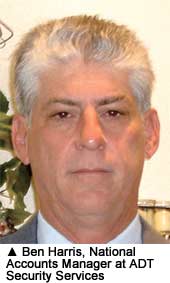A&S examines how the latest technologies are being used to provide high-end resorts and casinos with security.
A&S examines how the latest technologies are being used to provide high-end resorts and casinos with security. Resorts, villas, theme parks, casinos and shopping malls attract millions of visitors, and their scale can be truly massive. Gran Scala --- a US$11 billion entertainment city to be built on 2,025 hectares in the Aragon desert in Spain --- will include 32 casinos, hotels and five theme parks. The project --- the largest leisure complex in Europe --- is expected to welcome up to 25 million visitors annually and create 60,000 direct jobs.
In Singapore, two casino complexes --- valued at $7 billion --- will open in 2009 and 2010; they will draw an estimated 17 million visitors yearly and create 100,000 jobs. Analysts say the project is already shaping up to be the world's most expensive casino resort. The incredible revenue will account for 1 percent of Singapore's entire economy and increase GDP by 0.5 percent.
Manchester, Macau and Las Vegas are all examining plans to set up more casino resorts or expand and refine existing facilities. According to a report published by Ernst & Young, billions in new capital is being invested in the gaming industry.
Macau surpassed Las Vegas as the leading gaming center in the world in 2006, with $6.9 billion in annual revenue. Japan is also looking at whether to lift a longtime ban on casinos. Moreover, while the U.S. is still the largest single

gaming market with 1,496 casinos and gaming properties, the rest of the world has now sharply overtaken North America in terms of casino expansion , with 1,822 properties.
Global gambling revenue is growing 7.2 percent on average every year, according to recent PricewaterhouseCoopers report. In 2007, gambling revenue was $110.6 billion, which is expected to rise to $144 billion in 2011.
North America generated 35.3 percent of total global gross gaming yields in 2007, followed closely by Europe (35 percent) and Asia and the Middle East (19.3 percent). The Asian market is growing 15.7 percent per year, and the market should reach $30.3 billion in 2008.
With the surging numbers of casinos and visitors worldwide, the issue of security is becoming more important. A high-quality surveillance system not only safeguards visitor safety but also protects casinos from theft and fraud. According to a case study from IndigoVision, Specifying IP Video CCTV Systems for Casinos, casinos suffer from gaming disputes, fraud, cheating and theft. Effectively resolving these problems is a major issue.
"Casino employees have access to large amounts of cash, sensitive financial information on customers, mission-critical applications and vulnerable equipment," said Ryan Zlockie, Vice President of Marketing and Product Management at Bioscrypt. "With some casinos employing hundreds or even thousands of workers, determining whether an individual passing through an employee entrance, logging onto a database or entering an authorized area is not an easy feat."
Rising to the Challenge An IP video system can deliver advantages such as high image quality and frame rates, ability to conduct instant investigations, immediate failover capability, scalability and flexibility. High image quality is an essential business tool for casinos in resolving gaming disputes, monitoring public safety, and detecting fraud, cheating and theft. "Cameras have long been used in casinos," said Oh Tee Lee, Regional Director of the South Asia-Pacific Region at Axis Communications. "These must have a high standard of quality as well as day night capability."
To detect sleight of hand or subtle scams, full frame rate live viewing and review of

recorded footage is essential. Lowered frame rates, dropped frames or jerky stop-start video are unacceptable. Leading end-to-end IP video surveillance systems can stream and record high-resolution video continuously at 30 frames per second, whereas less capable, poorly specified systems achieve this performance only under ideal conditions, say when there is limited motion.
As surveillance operators also need to quickly analyze movement of suspected persons, ability to provide immediate playback for review --- even multichannel synchronized playback --- should be seamlessly integrated with live viewing. IP video technology enhances the way that users search and use recorded video footage. Casino surveillance teams can review disputes with instant camera recall to call up footage. Key features including easy camera selection with map overlay and instant replay facilities.
An immediate failover component must be available to eliminate any possibility of downtime. Employing VCR or DVR standbys is a common approach in analog video systems, but this requires that analog switches reroute video signals to standby units. Wiring all cameras to a standby system is not practical; system intelligence should drive these functions. Unfortunately, this usually has to be done manually.
A well-designed IP surveillance system, however, enables video recording to automatically be assigned to other NVRs in the system when a primary NVR fails. NVRs --- located at any point on the system --- have redundant power supplies and network connectivity that eliminates any single point of system failure.
Surveillance schemes are often updated when new slots machines or game tables are introduced. Solutions must be flexible to enable this and scalable. Given that more than 85 percent of casinos still use analog VCR systems with coaxial cables, replacing these with IP systems (cameras, networks, servers, recorders and monitoring stations) represents a major cost.
A good IP surveillance system allows a step-by-step upgrade to digital as budgets allow; a hybrid system can be created during migration. This is achieved using transmitter and receiver modules connected to existing cameras to compress analog video (MPEG-4 or H.264) for transmission. Modules can also convert digital video back to analog for display on existing TV monitors, allowing "hot" transmission.
In spite of the numerous advantages, there are still bottlenecks. Traditional analog CCTV systems have historically performed better than IP with regard to latency during video transmission. Live video surveillance is sometimes hampered when

latency is so high that joystick control is out of sync with camera movement. Fortunately, a competent IP video system can eliminate this problem by using proprietary codec designs and advanced digital video compression techniques coupled with good network infrastructure.
Another concern is collusion among security staff --- the inside job. This provokes the age-old question: "Who watches the watchers?" After all, CCTV operators with more oversight of security operations than anyone else can detect when they are being investigated and thus halt any illegal activity. High-end IP surveillance systems with supervisor mode allow outside investigators to record and control cameras without CCTV operators being aware that they are doing so.
Biometrics
Biometric technologies play an important role in quickly and securely authenticating hundreds or even thousands of employees at the beginning of each shift. "Biometric products should combine both security and convenience," said Zlockie. "If a casino uses a cumbersome access control method to secure entrances to restricted areas, it creates bottlenecks and prevents employees from efficiently carrying out their work." Two main biometric products widely used in casinos are face and fingerprint readers.
"Face readers --- designed for high-traffic areas --- make it possible to authenticate thousands of employees as they begin a shift," Zlockie said. "Fingerprint readers are designed for convenience, making matches in under a second."
The Venetian Resort Hotel in Macau, the world largest casino, has placed 13 face readers at employee entrances. The readers check faces against templates called up by RFID cards to make one to one matches. Readers are tied to a time and attendance system and turnstiles to ensure that only one employee can enter at a time.
The hotel has also placed 50 fingerprint readers at entrances to restricted areas. Employees have to re-authenticate themselves using fingerprints, which are checked against templates placed on smart cards. Layered biometric authentication like this significantly increases security.
Other technologies are at work as well. "We are seeing a lot of interest in networks comprising fiber optic cabling with IP switches and IP cameras where system intelligence moves from the core to its edge," said Ben Harris, National Accounts Manager at ADT Security Services. "Since IP is both universal and ubiquitous, security systems and management no longer need be confined to the immediate premises; they can be interconnected for centralized management from across a city or around the world."

Integration is another trend. Bioscrypt Veri-Series fingerprint readers not only support single, dual and triple-factor authentication, but also can be used in finger-only mode or in conjunction with personal identification numbers, proximity cards, smart cards or tokens.
Finally, data and video analytics will become more important. "Intelligent video analysis will play the key role in casino surveillance, as it can send a real-time alert to guards or control centers as soon as unusual situations occur," Lee said.
"We are seeing casinos using data and video analytics for exception reporting and predictive modeling, not only to turn security form its traditionally reactive mode to a more proactive one, but also to help manage business operations better," Harris said. Crowd management can be monitored with video analytics, alerting staff when certain thresholds are exceeded.